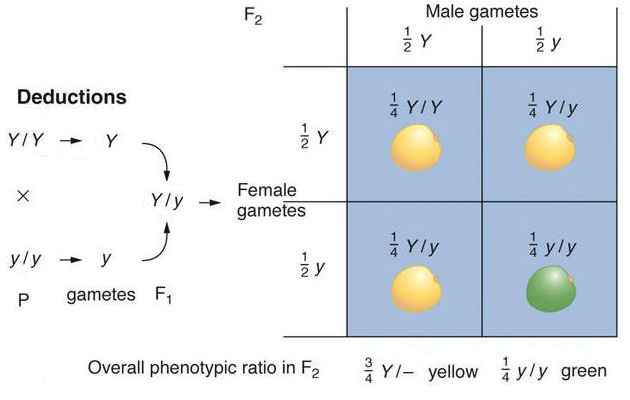
Mendel's explanation of the monohybrid cross:
The Laws of Dominance & Segregation
Mendel
hypothesized that seed colour and other phenotypic traits
are controlled by alternative forms of an inherited "element" (which we now
call a gene) in the parental
plants. Mendel started with two true-breeding lines of
plants in the P (Parental) generation, with
either yellow or green seed coats. Each
plant receives one factor (now
called an allele)
from each parent. The yellow plants have two copies of the "yellow"
factor (Y) and the
green plants two copies of the "green" factor (y). Their offspring (the
first filial or F1
generation of plants) receive one Y or one y
factor from either parent, and are thus uniformly Yy. Since these Yy plants are yellow
like the YY parent,
the Y factor can be said to dominate the y factor in determining
the appearance of the seeds. That is, the heterozygous Yy combination resembles the
homozygous YY combination,
rather than the homozygous yy combination. Classically, Y "masks"
y.
In gamete formation, the factors segregate (separate), so that each gamete carries only one or the other. One-half (1/2) of the female gametes are Y, 1/2 are y, and the same is true for the male gametes.
The probability of two independent events occurring together is the product of their independent occurrence (the "and" rule). Then, when two F1 Yy plants are crossed, the probability that any second-generation F2 plant will receive a Y from the female and a Y from the male is (1/2) x (1/2) = 1/4, and the probability of a y from both parents is also (1/2) x (1/2) = 1/4.
The probability of two alternative events occurring together is the sum of their separate occurrence (the "or" rule). Then, there are two ways of obtaining a Yy plant: either Y from the female parent and y from the male parent, or y from the female and Y from the male: (1/2) x (1/2) + (1/2) x (1/2) = 1/2
Finally, the probability of a plant being either YY or Yy is 1/4 + 1/2 = 3/4, and the probability of yy remains 1/4. The expected ratio of yellow ("Y-") to green ("yy") plants is 3/4 : 1/4 or 3:1, as observed.
Mendel showed that these results and ratios were obtained for seven separate traits in peas, including seed colour and shape, pod shape, and plant form.
In gamete formation, the factors segregate (separate), so that each gamete carries only one or the other. One-half (1/2) of the female gametes are Y, 1/2 are y, and the same is true for the male gametes.
The probability of two independent events occurring together is the product of their independent occurrence (the "and" rule). Then, when two F1 Yy plants are crossed, the probability that any second-generation F2 plant will receive a Y from the female and a Y from the male is (1/2) x (1/2) = 1/4, and the probability of a y from both parents is also (1/2) x (1/2) = 1/4.
The probability of two alternative events occurring together is the sum of their separate occurrence (the "or" rule). Then, there are two ways of obtaining a Yy plant: either Y from the female parent and y from the male parent, or y from the female and Y from the male: (1/2) x (1/2) + (1/2) x (1/2) = 1/2
Finally, the probability of a plant being either YY or Yy is 1/4 + 1/2 = 3/4, and the probability of yy remains 1/4. The expected ratio of yellow ("Y-") to green ("yy") plants is 3/4 : 1/4 or 3:1, as observed.
Mendel showed that these results and ratios were obtained for seven separate traits in peas, including seed colour and shape, pod shape, and plant form.